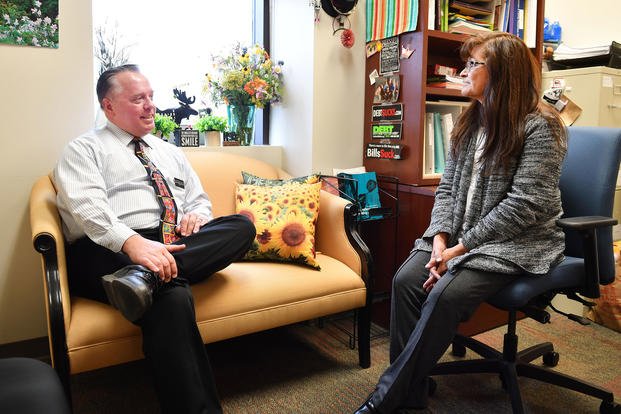Serving in the Army, Rick deployed to Iraq three times. Before his first deployment he was a fun-spirited, loving husband and doting father. He knew that deployment would be tough and did his best to keep himself feeling connected to home while dedicated to the job he was sent to do. Although he worked hard to stay emotionally balanced, the toll of multiple deployments and combat incidents built up. Now back at home he and his family are on a new mission: Learning to live with PTSD. For Rick, that means learning to cope with symptoms that often feel out of control. For his family, that means learning to live with Rick when he's argumentative, unpredictable and unsociable.
"I'm a totally different person," Rick says. "I used to be the first guy to go out and have some fun. Now, I just want to hide because I never know when a flashback will come on, or when something will set me off in such a panic that I can barely see straight."
All of this has Rick feeling very disconnected from himself. An honorable soldier and admired athlete, the sudden sense of powerlessness, embarrassment and anxiety has caused him to veer far from the values and actions that were once important to him. As a result, he feels not only alienated from his friends and family, but from himself as well.
The process of internal disconnection is typical after trauma. On the far end of the spectrum, some survivors experience aspects of dissociation (feeling disconnected from yourself) and derealization (feeling as if the world around you is unreal). Even without these extreme symptoms, it's normal to feel different than who you were. People often change after trauma. The effects of that change can amplify symptoms, lessen your ability to cope and impede resilience.
Effects of Change
With systems in the mind and the body continuously overreacting to cues from the past, how you define yourself in the present naturally shifts in important ways:
Who you were before – If you were already feeling unsure, unhappy or unimpressed with yourself prior to trauma, the dramatic shift in focus after the trauma, from living to coping, can exacerbate any negative thoughts and feelings you were already working to suppress. If you had a positive and solid view of yourself, the symptoms and powerlessness of the trauma can make it seem as if you are not who you used to be.
Who you are after – Dealing with stress, unpredictable outbursts and meltdowns, and the overstimulation that anxiety produces, can create an unflattering view of yourself. Caught in the cycle of rigidity, and chaos of symptoms' management, can leave you feeling unworthy and damaged.
Who you will be now – After weeks, and even months, of dealing with the effects of traumatic memories you may believe there is no hope, and that you will forever be this person that trauma molded. A defeated perspective saps your motivation for change and makes healing seem impossible.
Creating a new, post-trauma self
In trauma recovery, the first two tenets are creating a sense of safety and control. There are many ways to do that, ranging from actual experiences, to coping techniques, to building new relationships. One of the most powerful actions that support all three of those categories (and many others) is developing an internal sense of self that keeps you anchored to be the most strong, resilient, creative and adaptive parts of yourself.
Building a post-trauma identity is the concept of deliberately creating who you are outside of trauma. This means (re)developing your sense of self by choosing who you want to be, in spite of who you feel you have been or have become. It means imagining, accessing and developing your most valued traits, qualities and characteristics (the ones you used to have, or the ones you wish to develop) so that during times of stress there is more balance, versatility and power in your response.
Following a traumatic experience and in the grip of posttraumatic symptoms it's easy to see and define yourself through a lens that only notices those elements related to survival, your unique survival response, and the ongoing stress and coping mechanisms you've developed. But all of the trauma-related content of who you are is not the sum total of what it means to be you. You are so much more than your trauma history, narrative or current reactions. Developing a post-trauma identity brings all of the other content into the post-trauma perspective in order to open it up and bust out of it into a point of view that encompasses your whole self, not just your traumatized self.
Four steps to influencing positive change
Deliberately developing a post-trauma identity offers the chance to consciously choose who you wish to be as a person despite your past experiences and in spite of your present symptoms. To being this process try these simple steps:
Notice who you are today. Take some time to observe what you think, feel and do in a deliberately conscious, non-judgmental way.
Assess your observations. Outline everything you like and don't like about yourself. Be honest, specific and still, and suspend judgment.
Reflect on what you would like to change. Be clear on why those changes are important to you.
Act on your observations. Become deliberate about how you create new experiences that allow you to access more of what you like about yourself and less of what you don't like.
The process of developing a post-trauma identity takes time, deeply committed work, and a willingness to explore and discover new ways of seeing, accessing and inhabiting elements of your personality that make you feel strong, empowered and proactive. Identity, like your brain, is plastic. The opportunity for change both large and small ways is eminently present. The power behind the process of deliberately changing who you are is persistence. If you have the desire to recreate yourself it can be done, which means, you can start …. Now.
Visit http://afterdeployment.dcoe.mil/ to take a free and anonymous PTSD self-assessment.










